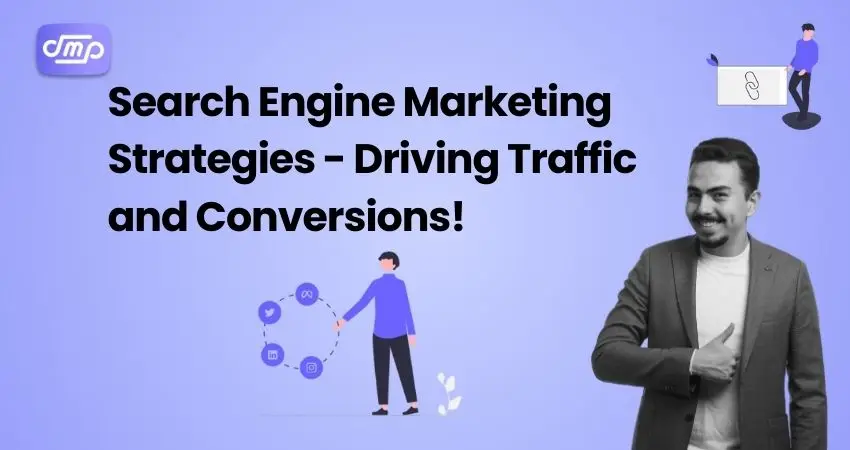
- October 3, 2024
- Content Writing, Digital Marketing
- Digital Marketing
Table of Contents
Search Engine Marketing strategies (SEM) is a digital marketing technique that uses paid advertising to boost a website’s exposure in search engine results, such as Google Ads . Businesses who bid on specific keywords can have their ads appear prominently when people search for related terms, generating targeted traffic directly to their website.
The value of Search engine Marketing strategies i.e SEM stems from its capacity to produce immediate results by reaching out to potential clients at the same moment they are looking for items or services. This focused method increases website traffic while also improving conversion rates, allowing organizations to achieve measurable growth and success in a competitive industry.
Key Search Engine Marketing Strategies to Drive Traffic

1. Keyword Research and Targeting
- Conduct extensive keyword research to find high-traffic, relevant terms for your business is one of the important search engine marketing strategies.
- To reach a large audience as well as niche customers, target both short-tail and long-tail keywords.
2. Pay-per-click (PPC) Advertisements
- Create PPC campaigns utilizing platforms such as Google Ads.
- Bid on relevant keywords to have your adverts appear at the top of search engine results.
- To maximize reach, use a combination of search, display, and retargeting advertisements with search engine marketing strategies.
3. Ad Copy Optimization
- Create interesting, keyword-rich ad copy that attracts attention and encourages clicks.
- To attract potential clients, use unambiguous calls to action (CTAs) and showcase your unique selling points (USPs).
- Continuously A/B to increase click-through rates (CTR), continuously A/B test different headlines, descriptions, and CTAs.
4. Ad Extensions
- Use ad extensions (such as site link, call, and location extensions) to increase the visibility and impact of your ads.
- Providing additional information through extensions increases the likelihood of visitors clicking on your advertisements, resulting in greater traffic.
5. Landing Page Optimization
- Ensure that your landing pages are relevant to the ad and keyword being targeted.
- Improve user experience and reduce bounce rates by optimizing landing pages for speed, mobile friendliness, and a clear CTA.
6. Remarketing Campaigns
- Displaying remarketing advertising across the web allows you to target customers who have previously visited your site but have not converted.
- Utilize dynamic remarketing to display targeted advertisements depending on depending on user behavior or past experiences with your website.
7. Budget Management and Bid Strategies
- Determine an acceptable budget and bidding strategy (human or automated) based on campaign objectives.
- Adjust bids for high-performing keywords to optimize ad budget while pausing ineffective ones.
8. Geotargeting & Ad Scheduling
- Use geotargeting to show advertisements just to users in certain locations relevant to your business.
- Set up ad scheduling so that your adverts appear during peak hours when your target audience is most active.
- Businesses can use these SEM methods to deliver more targeted visitors to their websites, increasing visibility and conversion rates.
How SEM Can Boost Conversions

Search Engine Marketing Strategies (SEM) may greatly increase conversion rates by targeting the correct audience at the right time with highly relevant adverts. Here are three important ways SEM improves conversions:
1. Targeted Audience Reach
- Bidding on relevant keywords allows firms to contact potential clients at the optimal time for conversion.
- You can also refine your targeting using demographic, geographic, and behavioral variables to ensure your advertising reach the most qualified leads.
2. Effective ad copy and CTAs
- Highlighting exceptional deals, promotions, or unique selling propositions (USP) in the ad copy can encourage viewers to click and convert.
3. Optimized Landing Pages
- SEM campaigns drive viewers to landing pages that are optimized for the ad’s intent and message. A well-designed landing page that focuses on a certain product or service enhances user experience and increases conversion rates.
- Fast loading speed, smartphone friendliness, and simple layouts all help to increase conversion rates.
4. Conversion Tracking and Measurement
- SEM solutions, such as Google Ads, offer powerful conversion tracking and measurement features. You may create targets, track leads, purchases, and other actions, and alter campaigns depending on results.
- This data enables you to focus on the keywords, advertising, and landing pages that produce the highest conversion rates, so optimizing future campaigns.
5. Remarketing Campaigns
- SEM’s Remarketing Function SEM’s remarketing feature allows firms to retarget users who have previously visited their website but have not converted. Showing personalized adverts to these users boosts their chances of converting on subsequent visits.
- Remarketing ads are effective because they target warm leads who are already familiar with the brand, hence increasing overall conversion potential.
6. A/B Testing for Continuous Improvement
- SEM enables organizations to A/B test various ad variations, including headlines, ad copy, CTAs, and landing sites. Running several tests allows you to understand which versions resonate most with your target audience and result in higher conversions.
- Continuous testing and optimization improve the campaign’s conversion rates over time.
7. Quality Score Improvement
- The Google Adverts Quality Score defines how relevant your adverts are to users.
- Higher Quality Scores result in better ad placements at reduced prices, which boosts overall ad performance.
- Businesses may enhance conversions and optimize their ad budget by enhancing ad relevancy, keyword alignment, and landing page quality.
By properly integrating these methods, SEM not only increases traffic but also enables a smooth transition from search to conversion, converting leads into customers and enhancing overall business performance.
Best Practices for Search Engine Marketing Success
To succeed with Search Engine Marketing (SEM), you must adhere to important best practices that allow you to maximize visibility, attract the correct audience, and get a high return on investment (ROI). The following are some of the top techniques for SEM success:
- Concentrate on keywords that show a strong desire to convert (such as “buy,” “best price,” and “hire”).
- Use tools such as Google Keyword Planner, SEMrush, or Ahrefs to identify the most relevant and cost-effective keywords.
- Targeting lengthier, more precise terms can result in decreased competition and increased relevance.
- Use calls-to-action (CTAs) to motivate visitors to take prompt action.
- Show what makes Make your product or service stand out by offering free shipping or exceptional discounts.
- Testing versions of your ad wording, headlines, and CTAs on a regular basis will help you determine what works best.
- Make sure your landing page matches the ad content, both in terms of keywords and intent.
- Slow pages might cause significant bounce rates, lowering your Quality Score and overall performance.
- Keep the layout minimal, with a visible call to action that encourages visitors to convert.
- Customize advertising depending on user age, geography, gender, and other criteria to ensure relevancy.
- Consider employing Google’s automatic bidding tactics, such as Target CPA or ROAS, to improve conversions.
- Set up conversion tracking for important actions like purchases, sign-ups, and contact form submissions.
- Keep an eye on your Quality Score and take steps to improve elements like as ad relevance, click-through rate (CTR), and landing page experience.
- To quantify success, track performance indicators such as CTR, CPC, and ROAS.
- Include connections to other pages on your website to increase engagement.
- Highlight additional perks, such as free returns or 24-hour customer service.
- Make it easy for mobile users to locate your store or contact you directly.
- Adjust your keyword strategies. Remove low-performing keywords and replace them with new ones as search trends change.
- Examine performance on mobile versus desktop and optimize accordingly.
- Utilize Google’s Smart Campaigns to automate many of the Automate much of the ad placement and targeting process using machine learning. Dynamic search advertisements allow you to match user queries with highly relevant landing sites without having to provide keywords.
- Search engines often adjust their algorithms and policies, so be aware of any changes in Google Ads. Adapt your strategy to changing user behavior, seasonal trends, or new items.
By implementing these best practices, you can enhance your SEM approach, raise your exposure on search engines, and ultimately achieve more conversions and commercial success.
Conclusion
Success in Search Engine Marketing strategies (SEM) necessitates a data-driven strategy. Businesses may greatly increase their visibility and conversions by focusing on detailed keyword research, creating attractive ad text, optimizing landing pages, and employing audience targeting. Regular campaign monitoring, testing, and refining, combined with remaining current on industry trends and platform improvements, ensures long-term growth and ROI. Implementing these best practices can assist you in creating effective SEM campaigns that produce measurable results, hence increasing the impact and profitability of your marketing activities.











